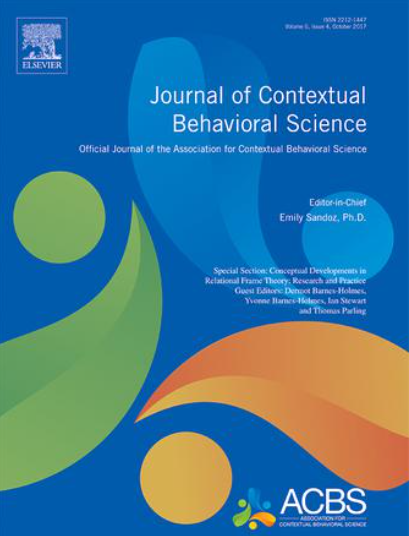Examining the effects of process-based therapy: A multiple baseline study
IF 3
3区 心理学
Q1 PSYCHOLOGY, CLINICAL
引用次数: 0
Abstract
Process-based therapy (PBT) is a model of psychological assessment and treatment focused on processes of change within particular people in their unique context. Many theoretical articles have been published on PBT, but few empirical studies explicitly examining PBT exist. The current study aimed to examine the effects of PBT using a multiple baseline design (N = 5) with intensive longitudinal assessment from baseline to 6-month follow-up. Overall, idiographic outcomes improved over time, with effects varying by participant. Gains appeared to be maintained at 6-month follow-up for two of three participants. In addition, individual-level networks contained fewer pathways overall or more inhibitory pathways over time, indicating that the relationships among symptoms changed over the course of treatment. At the same time, extent of change in standardized outcomes across participants varied and certain pathways in participant networks were consistent at multiple timepoints, suggesting that treatment was not universally effective across problem indices. The present study provides a proof of concept for PBT delivery and underscores the need to consider person-level outcomes when evaluating treatment efficacy. Future directions and limitations, including small sample size, are discussed.
以过程为基础的治疗效果检验:一项多基线研究
基于过程的治疗(PBT)是一种心理评估和治疗模式,专注于特定人群在其独特环境中的变化过程。关于PBT的理论文章很多,但明确考察PBT的实证研究很少。目前的研究旨在通过多基线设计(N = 5),从基线到6个月随访期间进行深入的纵向评估,来检查PBT的效果。总体而言,个别结果随着时间的推移而改善,其效果因参与者而异。在6个月的随访中,三名参与者中的两名似乎保持了收益。此外,随着时间的推移,个人层面的网络总体上包含更少的途径或更多的抑制途径,这表明症状之间的关系在治疗过程中发生了变化。同时,参与者标准化结果的变化程度各不相同,参与者网络中的某些途径在多个时间点上是一致的,这表明治疗并非在问题指数中普遍有效。目前的研究为PBT的概念提供了证明,并强调在评估治疗效果时需要考虑个人水平的结果。讨论了未来的发展方向和局限性,包括小样本量。
本文章由计算机程序翻译,如有差异,请以英文原文为准。
求助全文
约1分钟内获得全文
求助全文
来源期刊

Journal of Contextual Behavioral Science
PSYCHOLOGY, CLINICAL-
CiteScore
8.50
自引率
18.00%
发文量
82
审稿时长
61 days
期刊介绍:
The Journal of Contextual Behavioral Science is the official journal of the Association for Contextual Behavioral Science (ACBS).
Contextual Behavioral Science is a systematic and pragmatic approach to the understanding of behavior, the solution of human problems, and the promotion of human growth and development. Contextual Behavioral Science uses functional principles and theories to analyze and modify action embedded in its historical and situational context. The goal is to predict and influence behavior, with precision, scope, and depth, across all behavioral domains and all levels of analysis, so as to help create a behavioral science that is more adequate to the challenge of the human condition.
 求助内容:
求助内容: 应助结果提醒方式:
应助结果提醒方式:


